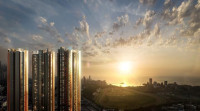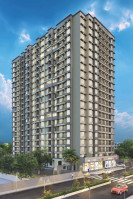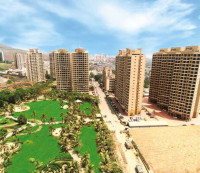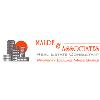The capital of Maharashtra, Mumbai is the most populous city in India with a total headcount of 1.25 crores. Having a limited land area of 603.4 sq. km to suffice the unlimited population of this city is a big challenge for the government. It puts pressure on the shoulders of developers to meet the housing needs of the residents appropriately. High property values and scarce land availability define Mumbai India real estate. Still, the city continues to attract many domestic and international investors. The modern culture and high-end lifestyle of the residents here contribute a lot to the never-ending demand for luxury residential and commercial properties.
The real estate market of Mumbai has seen several upward trends over the years. It is the financial capital of India and the alpha world center. It even accommodates the highest number of billionaires in Asia. So, let's navigate to the city’s real estate sector and find out how it is evolving at such a great pace.
Current Trends in the Real Estate Market
A recent registration of 10901 properties in January 2024 has added stars to the glittering skyline of Mumbai. This was further fueled by a registration of 8901 properties in MMR ( Mumbai Metropolitan Region) during February. This flooded the government of Mumbai with a revenue of Rs 746 crores. The Mumbaikars' growing disposable income has increased the demand for luxury housing solutions. The trend in super-luxury will continue in the upcoming years. And we will see the homes priced at a new record of Rs 2 lakh/square feet. While the prices may look undesirable for the middle-class section, the preferences of the niche super-luxury segment are different.
Moreover, government initiatives like Pradhan Mantri Awas Yojana and other projects rolled out by the Maharashtra Housing and Area Development Authority (MHADA) have made homeownership a workable option for many. With such policies, Mumbaikars are now opting to buy homes rather than renting. A major reason for this shift is the parity between the rental rates and EMIs. Low EMIs make homeownership an affordable option.
Key Factors Driving the Real Estate Market
Be it homeowners or commercial property buyers, the percentage of all has increased. This is irrespective of the rising property prices in Mumbai and mortgage costs. Several interrelated factors are influencing the Mumbai realty sector. Let's check out a few of them
- Growing population and limited land-
The population of Mumbai continues to increase in geometric progression and the land is limited in this coastal city. This has created an irreversible upward trend in property prices in Mumbai. Moreover, GenX is highly inclined towards having properties with upscale amenities that further drive the Mumbai property rates. The builders in Mumbai are gearing up to meet the soaring demand and stabilize the home prices in Mumbai.
We can credit the expansive roadways, flyovers, and Mumbai Metro for the infrastructure of this city. Andheri-Malad flyover, Gokhale Bridge-Barfiwala flyover, Bandra Worli Sea Link, the upcoming flyover to decongest the Chheda Nagar junction, and other eminent developments have changed the face of Mumbai. Apart from this, MSRDC is on its way to developing 50 flyovers in the city to solve the traffic problem. This will improve the transportation system and attract more investors to buy property in Mumbai.
- Advancements in Mumbai Micro Markets-
Several micro markets in Mumbai are now developed real estate hubs. Areas like Maland, Chembur, Dombivili, Kanjurmarg, Worli, Lower Parel, etc. offer many luxury flats for sale in Mumbai. The advancement of these micro markets has pulled up the Mumbai real estate sector to a great height. The Micro Markets in Mumbai are dotted with the properties offered by the top builders in Mumbai including Ruparel Orion Chembur, Oberoi Enigma Mulund, Godrej Serenity Chembur, Godrej One Vikhroli East, and others. Consulting a real estate broker in Mumbai to get a flat in Bandra or a flat in Juhu is never a bad option
So, the city will continue to enjoy a major transformation in the real estate sector. It is expected to get a major influx of investments with many new developments of Bombay properties that may stabilize Mumbai flat prices.
Types of Properties in Mumbai
Different types of properties are available for sale and buy in Mumbai. The real estate brokers in Mumbai offer a vast variety of property to meet the needs of different segments. It caters to the needs of high-profile residents, middle-class, and low-income groups in the best possible manner. Let's check out the current trend of the different types of properties in Mumbai
The real estate brokers in Mumbai offer several types of affordable and high-end housing solutions. Currently, the city is witnessing a rise in the trend of luxury properties. As per the latest Mumbai real estate news, Mumbai is now among the top 10 luxury residential markets in the world. The city is ranked at number 8 globally for price growth in luxury housing. These properties are spacious and are equipped with upscale facilities for the utmost comfort of the occupants. Many High Net Worth Individuals (HNI) can afford to live in a luxurious bungalow in Mumbai. Mumbai’s rank has improved to 8th on Knight Frank’s PIRI’s index in 2023 as compared to 37th rank in 2022 which is a phenomenal jump of 10% year-on-year growth in terms of annual luxury residential price rise. Most of the residential areas in Mumbai like Colaba, Cuffe Parade, Andheri, Juhi, etc have many gated colonies and townships with high-end amenities. Those looking for affordable housing solutions can opt for areas like Khargar, Goregaon, Ghatkopar, etc. These have become an ideal choice for the homebuyers. This is despite their cost being 10-15 % more than the regular homes in Mumbai. Their tight security systems and restricted accessibility for outsiders can be credited for the soaring demand for gated colonies. Most of these colonies have luxury flats in Mumbai to please the peculiar demands of investors.
Having a strong infrastructure and connectivity, Mumbai is a perfect city for commercial activities. The presence of BSE and NSE makes Mumbai a commercial hotspot. Office spaces facilitated with a recreational center, cafe, upscale furniture, etc can be spotted in Lower Parel, Bandra Kurla Complex (BKC), Nariman Point, Andheri, Goregaon, etc. Mumbai saw a tremendous growth in office spaces. Mumbai saw a 22% increase in office space absorption in the first quarter, with a total of 2.5 million square feet of transactions. The IT and BFSI sectors led this demand, accounting for 45% and 20% of the total leasing activity, respectively.
The Central Business District, Secondary Business District, and Peripheral Business Districts are a hub of Mumbai commercial real estate. Knight Frank’s research indicates a significant rise in commercial real estate investments, with Mumbai attracting approximately USD 1.2 billion in the first half of the year 2024. The report emphasizes the growing preference for Grade A office spaces, which appeal to both multinational corporations and domestic enterprises looking to expand. Moreover, Mumbai has witnessed a major trend in demand for co-working spaces with a growth of 27% in rental rates of co-working spaces. BKC leads with the highest rental rates, averaging INR 350 per square foot per month, reflecting strong demand and limited supply in premium locations. This indicates a prosperous commercial real estate market in Mumbai. So, if you are planning to invest, optimise by infusing capital in the rapidly transforming Mumbai real estate. Just contact a reputed real estate agent in Mumbai and set up your dream office in this bustling city.
Popular residential areas in Mumbai
- South Mumbai- South Mumbai aka SoBo comprises residential properties with the highest prices in India. Taj Mahal Hotel, Bombay Harbour, and Gateway of India are some of the landmarks of Sobo. Having a total area of 26.1 sq miles, it accommodates posh areas like Colaba, Dadar, Cuffe Parade, Marine Drive, Fort Area, and others. This area is known for having some of the most expensive flats in Mumbai at an average price of Rs. 38,371. The recently inaugurated Mumbai Coastal Road is expected to refresh the residential real estate market of South Mumbai. Moreover, it is also adorned by a 3-kilometer-long roadway that goes along the Arabian Sea surrounding the city of Mumbai. As the street lights illuminate at night, the coastline looks like a Queen’s Necklace. This bustling locality has several sea facing flats in Mumbai to offer to the potential investors. So peeps, get in touch with the real estate agents in South Mumbai to buy a residential property in Mumbai.
- Western Suburbs- It is one of the oldest suburbs of Mumbai. The presence of several BPO and software companies has led to a rise in demand for residential properties for the working population. Some of the prominent areas of this 93.7 sq miles suburb are Andheri, Bandra, Borivali, Goregaon, Malad, Kandivali, Juhu, and others. The average price of properties in Western Suburbs is Rs. 22,161 per sqft. The amazing Bandra-Worli Sea Link connects this area to South Mumbai making it highly accessible for the commuters. Moreover, the upcoming 14 new metro lines and Goregaon-Mulund Link Road will add to the splendor of this area. Housing the commercial hub of Bandra Kurla Complex makes it an ideal choice for homebuyers too. Morya House Andheri West, Shreedham Splendour Andheri West, Oberoi Woods Goregaon, Ceejay House Worli, Raheja Residency Malad East, etc. are the major luxury flats in Mumbai.
- Central Mumbai- It is a major residential and commercial hub in the city. It is dotted with several educational institutes like Lala Lajpat Rai College, Tata Institute of Social Sciences, etc., and malls like Hirapanna Shopping Center. This area is highly sought after by middle-class real estate investors as the average property price here is Rs. 30,081. It consists of areas like Vikhroli, Powai, Chembur, Dadar, Lower Parel, and much more. Accommodating the Central Mumbai Railway Station, this area connects Mumbai with the whole of India. So, get in touch with the prominent real estate agents in Chembur Mumbai to get your dream house in Mumbai.
- Navi Mumbai- It is a part of the Mumbai Metropolitan Region (MMR) located next to Mumbai with an area of 132.82 sq miles. This region consists of areas like Vashi, Nerul, Panvel, Belapur, Kharghar, Seawood, etc. having an average property price of approximately Rs. 25100. These amenities include the Ryan International School, Apeejay School, D.Y. Patil University, MGM Hospital, Fortis Hospital, Inorbit Mall, Central Mall, and much more. Its proximity to different essential services makes it a viable option to get a flat for rent in Mumbai. It is connected to the main city of Mumbai with MTHL and even has the starting point of the Mumbai-Pune Expressway in Kalamboli. Contact the best real estate brokers in Mumbai to take the opportunity out of this transforming neighborhood.
Emerging Real Estate Hotspots
Areas Witnessing Rapid Development
Areas Witnessing Rapid Development The ease of commutation, development of essential services, and updated lifestyle preferences of the residents have led to the emergence of some unrivaled real estate hotspots in Mumbai. These areas are dotted with some of the best offices and houses for sale in Mumbai. Some of them include-
- Chembur- Being centrally located and an ideal blend of residential and commercial properties, Chembur is a neighborhood to look out for. Veena Serenity and Crystal Armus Chembur are highly sought-after by potential real estate investors. Just get in touch with the real estate dealers in Mumbai to get the best deals on such residential projects.
- Ghatkopar- It caters well to the mid-segment and offers many affordable apartments for sale in Mumbai. It is dotted with several 1 bkh flats in Mumbai to please the mid-segment investors. This vibrant neighborhood offers Mumbai apartments for rent and sale with many modern amenities.
- Andheri, due to its great proximity to the Mumbai Airport and accommodating the ultra-busy Andheri Railway Station. Getting a flat in Andheri East for rent is a great option. Get in touch with the real estate agents in Andheri East Mumbai to grab the best deals.
- Goregaon, the upcoming real estate projects of popular real estate developers in Mumbai like Oberoi Realty Limited Mumbai have given a great boost to this area. Moreover, its proximity to Western Express Highway cannot be ignored.
Most of these areas have several infrastructure projects lined up with the continually expanding Metro Project. Apart from these, Mulund, Thane, Borivali, Khargar, Vashi, and Gorai are witnessing a surge in demand for real estate properties. Well, it is always suggested to consult reliable real estate companies in Mumbai before buying a new Bombay property. Moreover, you must conduct thorough research on the ongoing market trends before you buy a property in Mumbai.
Upcoming Infrastructure Projects in Mumbai
The ongoing projects in Mumbai are surely going to put stars to the real estate market of this city. In March, the Maharashtra government allowed the planning and infrastructure development agency to raise loans to ₹60,000 crore from public institutions. It has also received a proposal to raise an additional ₹30,000 crore. The money will be used to make metropolitan Mumbai future-ready, with the development of metro lines, road tunnels, solid waste management projects, and enhanced rail systems, among others. So, soon Mumbai real estate will be more profit-making than gold. MMRDA and the central government’s public policy think tank NITI Aayog are jointly working towards raising Mumbai’s gross domestic product from $140 billion to $300 billion by 2030. This funding will surely fortify the overall infrastructure of the city thereby attracting several domestic and foreign investors. Well, the updated infrastructure will affably impact the Mumbai real estate prices.
Some of the major upcoming and recently completed infrastructure projects in Mumbai include the following-
2.5 km long Flyover below the Metro line 6- Metro 6 will integrate with four other Metro lines. This will add to the two suburban railway stations. The Mumbai Metropolitan Region Development Authority (MMRDA) will construct a combined 2.58-kilometre-long road flyover below the elevated Metro Line 6 (Swami Samarth Nagar to Vikhroli). This will ease the traffic and improve connectivity in several areas.
The elevated Mumbai Metro 6 passes through Jogeshwari, WEH, and Powai comprising the 15.31-km elevated corridor that will form a vast metro network, connecting four other metro corridors namely Metro Line 2A (Dahisar to DN Nagar), Metro 3 Colaba Bandra SEEPZ, Metro 4 (Wadala – Kasarvadavali) and Metro 7 (Andheri (East) – Dahisar (East)), apart from two suburban railway stations – Kanjurmarg and Jogeshwari. This is one of the most prominent projects that will boost the Rapid Transit System in Mumbai. The expected cost of this double-decker bridge would be around Rs. 67000 crores and will take a few more years to take off.
Mumbai Trans Harbour Sea Link- Officially known as the Atal Bihari Sewri-Nhava Sheva Atal Setu, is a 21.8 km 6-lane grade-separated expressway. It is the longest in India and the 12th longest in the world. Connecting Mumbai to Navi Mumbai aesthetically, this link has the competence to handle around 70000 vehicles per day. It will reduce the traveling time from 2 hours to 15-20 minutes. The Mumbai Trans Sea link is an epitome of engineering recently inaugurated by the honorable Prime Minister, Mr. Narendra Modi on 12th January 2024. The development of this engineering marvel is sure to stir the economic market of Mumbai by creating more opportunities in Navi Mumbai. It has even reduced the distance between the Mumbai-Pune Expressway and will provide great connectivity to the upcoming Navi Mumbai International Airport.
Navi Mumbai International Airport- The good news is that the under-construction Navi Mumbai International Airport will be operational this year. This will take some load off the shoulders of the current Mumbai Airport, which is one of the busiest in the world. Situated in Navi Mumbai, it is well-connected to the main city via the Mumbai Trans Harbour Sea Link. This airport is expected to handle a capacity of around 20 million passengers annually. And by 2032, it is expected to have a capacity of handling 90 million passengers per year. Although the Airport will be operational by Dec this year, the whole project will be completed by 2032. It is designed to provide parking space to 42 aircraft and will have 3 interconnected terminals. The development of this airport is expected to boost the Mumbai economy by creating employment opportunities and an influx of foreign investments.
Mumbai-Ahmedabad Bullet Train Corridor- This high-speed railway line will soon connect Mumbai and Ahmedabad. The trains will operate at a speed of 320 Km/hr covering a distance of 508 Km and 12 Stations. There will be 35 trains per day/one direction, with a frequency of 20 mins in peak hours and 30 mins in non-peak hours.
The entire journey will be completed in about 2 hours 7 minutes with limited stops (at Surat, Vadodara, and Ahmedabad) and all stops service will take 2 hours 58 minutes. The Operations Control Centre for the MAHSR corridor will be located at Sabarmati. By connecting India’s financial hub aka Mumbai with India’s industrial hub aka Ahmedabad this bullet train will be a transforming factor for the real estate market of India.
Apart from these, the exponentially expanding Mumbai Metro, Mumbai Coastal Road, Dharavi Slum Redevelopment project by Adanai Group, Mulund-Goregaon link Road, Thane-Borivili Tunner, etc. are some of the other projects in Mumbai. Pheww! The list is surely never-ending as the MMRDA is leaving no stone unturned in making this future city a perfect real estate hub.
Investment Opportunities in Mumbai
Analysis of ROI in various neighbourhoods
There are many established areas and emerging real estate hotspots in Mumbai. Despite the demand-supply challenges, Mumbai witnesses a high investor activity. Areas like South Mumbai, Malad, Juhu, etc. are posh areas having a high rental value. Whereas developing areas of Navi Mumbai, Thane, and Andheri offer enormous affordable options to the middle segment. Here we provide an overview of Return On Investment in different neighbourhoods of Mumbai-
- High Return Areas- Areas like Colaba, Malabar Hill, Bandra, Worli, Lower Parel, and Marine Drive are known for exuding luxury and premium lifestyle. These areas offer a high ROI for being one of the most prominent locations in the country. Such neighborhoods are even sought-after by foreigners and NRIs as the lifestyle is somewhat similar to the Western culture. Most of these localities are dotted with several ready to move 3 bhk flats in Mumbai.
- Moderate Return Areas- Bandra, Andheri, Juhu, Versova, Kandiwali, Boriwali, etc. are some of the areas offering a moderate return on investment. These areas are indeed loaded with several options for recreational activities. This makes them popular among the working professionals. Dotted with several luxury flats and studio apartments in Mumbai, these neighborhoods are a major contributor to the soaring real estate sector of Mumbai.
- Promising areas that commit a high future ROI- Navi Mumbai is surely an emerging real estate market in the city. With connectivity to the main city via Atal Setu and accommodating the upcoming International Airport (NMI), this area is continually shaping itself to become an emerging real estate market.
Government initiatives and policies favoring real estate investment
The Maharashtra Government leaves no stone unturned in making this city a better place to live. It regularly rolls out different schemes and policies to meet the demands of Mumaikars. Let’s check out some of the government policies that will integrated into the city’s real estate sector-
Implementation of RERA and GST- RERA was implemented in May 2017 to make real estate transactions transparent and reliable. It has made it mandatory for the developers to register their projects and provide updates about the percentage of completion from time to time. Moreover, the builders are subject to penalties if the project gets delayed. It even ensures speedy settlement of property disputes. This has gained buyer’s confidence and as of 2022, around 27000 projects and 25000 real estate agents are registered under this Act.
On the other hand, GST was introduced in July 2017. With this, the government rolled out a unified tax structure to reduce the tax burden on developers and investors. This phenomenal step by the Indian Government has abolished the cascading effect and simplified the taxation system
Amendment of Benami Transactions Act- With this act implemented in 2016, the government has put restrictions and charges with respect to the dealings pertaining to Benami Transactions. It aims to settle the disputes related to such transactions and imposes penalties. Making the real estate transactions more accountable, this Act has made the Mumbai real estate sector even more attractive.
100% deduction in profits for the development of affordable housing projects- The inclusion of Section 80IBA of the Income Tax Act has immensely favored the developers undertaking affordable housing projects. It is applicable all over India. The real estate developers in Mumbai are authorized to claim a 100% deduction in profits made out of developing such projects. However, it can be claimed for 5 consecutive years only if certain conditions are complied with. The profits must be from a housing project for flats up to 30 sq meters in four metro cities and 60 sq meters in other cities. These projects have to be approved from June 2016 to March 2019. Another condition was that the project should be completed within three years of grant of approval. This policy offers a sense of relief to the popular builders in Mumbai.
Indexation on LTCG Benefit under Union Budget 2024- As per the revised Union Budget, 2024 on 6th August 2024, the removal of indexation benefit on LTCG, earlier proposed this year, has been reversed. It ensures that properties bought before the specified date (July 23, 2024) are not adversely affected by the new rules.
There will be two options for property owners now while selling their properties and they can go for the one where they have lower tax.
1) Compute the tax on long-term capital gains on the sale of immovable property at 20% after factoring indexation benefit.
2) Compute the tax on long-term capital gains on the sale of immovable property at 12.5% without factoring indexation benefit.
This will definitely justify those keeping the properties as a long term asset
Pradhan Mantri Awas Yojana- Urban 2.0- Urban 2.0- Under the Union Budget 2024, the government has planned to set aside a handsome amount for the development of urban housing projects in cities like Mumbai, etc. This Yojana aims to provide houses to around 1 crore poor and low-income families. So, the developers will get the benefit of a 100% deduction in profits on meeting the government laid rules and make the residents of Mumbai, homeowners of a house in Mumbai, India. So, it's a jackpot scheme for developers and investors alike.
Apart from these, the Energy Conservation Building Code ( ECBC) and Green Rating for Integrated Habitat Assessment ( GRIHA) are other eminent government policies. These are aimed at benefitting those who are adopting sustainable construction practices by using eco-friendly materials and emitting less pollution in the air and water.
Trends of the Real Estate Market in Mumbai
The real estate market in Mumbai has been booming for the past 10 years. The people here now prefer residences with upscale amenities because of a tremendous increase in disposable income. The city has witnessed a year-by-year increase of around 21% in the new registrations of properties thereby reflecting the soaring demand. As narrated at the beginning of this article, Mumbai has witnessed a registration of 10901 properties in January 2024. Though residential property registrations are quite higher as compared to other property types. Around 84% of the total registrations are residential and the remaining 16% are non-residential. Despite the rising Mumbai apartment prices, the financial capital has seen a surge in demand for luxury properties over the years. Apartments measuring 500 to 1000 sq. ft remain highly sought-after in the current market scenario, accounting for 41% share. The share of sale of homes up to 500 sq. ft was 35%; and for areas more than 1000 sq. ft, the share take-up remained 24% as of May 2023. Moreover, there is a major transformation in the mindset of Mumbaikars. They are now more inclined towards homeownership than getting a rented house for sale in Mumbai. So, people now prefer buying larger homes in Mumbai for a comfortable living and opt for homeownership that leads to asset formation. This growing trend is prevailing irrespective of the soaring home price in Mumbai.
Future Projections
As per the National Real Estate Development Council (NAREDCO), the property sale figure is expected to cross the whopping figure of Rs 2 lakh crores by 2030. The upcoming projects for the mid-segment and continually changing preferences of the residents will shape the city’s dynamics and make it future-ready. According to the report, the pace at which the city is developing is surely going to improve east-west connectivity, enhance public transportation, and reduce travel time. The average travel time is expected to decrease by 50 percent over the next five years. The expansion of Metro Rain at an exponential pace can be credited to such figures. As a result, the public transportation modal share is anticipated to rise from 65 percent in 2016 to 75 percent in 2030. So, what more can the commuters ask for? This will make the city an even more attractive investment option in the future.
Commercial Real Estate- Overview of Commercial Real Estate Options
The city has been thronged by many international brands and foreign investors over the past 10 years. Many corporate firms consider Mumbai for setting up a new office and making impressions on the Indian market. Investment in Central Business Districts, Secondary Business Districts, and Peripheral Business Districts can never fade our invested money. These are sure-shot profit-making areas providing a low risk and high ROI. The development of all-reaching flyovers and Metro Rail has made it highly convenient for the working population to commute within Mumbai at a better pace than before. Such infrastructural developments have played a phenomenal role in changing the dynamics of the commercial real estate market in the financial capital. So, if you wish to put your foot in this high-spirited commercial market, contact the best real estate agents in Mumbai.
Conclusion
With all this information about the city, we can conclude that the Mumbai property market has undergone significant changes in the past 10 years. Well, it won't be an understatement that the future transformation will be way more gigantic than the past. With record-breaking sales this year, changing preferences of the residents, and expanding infrastructure, Mumbai realty is on its way to emerge as one of the most promising in the world. Property websites like Realestateindia.com present an extensive list of residential and commercial properties in Mumbai suiting your needs So, pick a real estate broker in Mumbai listed on Realestateindia.com to get the best deals. Just keep track of the economic fluctuations and make the most out of the opportunities offered by the Mumbai real estate market.
Frequently Asked Questions About Mumbai Real Estate
Question 1: What are the average property prices in Mumbai?
Answer: The average residential property price per square foot is Rs. 20345 in 2024. Whereas the property price range is from Rs. 220 to Rs 1 lakh depending on the location, property type, age, construction, etc.
Question 2: Which are the best areas to buy residential property in Mumbai?
Answer: The best areas to buy a luxury property in Mumbai include, Bandra, Colaba, Malad, Cuff Parade, etc. while the best areas to buy an affordable one include Borivali, Kandivali, Kurla, Goregaon, Ghatkopar, etc.
Question 3: What should I consider when investing in commercial property in Mumbai?
Answer: A few tips for investors while looking for a commercial property in Mumbai include the following-
- Check out the materials used for construction to get an idea of structure strength
- Make sure that the area is well connected via roads and Metro
- It must have a decent proximity to amenities like shopping centers, hospitals, etc.
- Keep a check on the credibility of the developer and the project must be RERA approved.
- Chart down the maintenance expenses, property insurance expenses, lock-in period, lease documents, etc. for a full-proof deal.
Question 4: How is the rental market in Mumbai?
Answer: The city is witnessing a decent demand for rented homes in Mumbai. Despite the rising flat cost in Mumbai, the rental market is thriving. This is due to the growing employment opportunities. Though the city is witnessing a shift from renting to homeownership.
Question 5: What are the legal requirements for buying property in Mumbai?
Answer: Some of the documents mandatorily required for buying a property in Mumbai include-
- Photo ID
- Property tax bills
- Bank Account Details
- Proof of Residence
- PAN card
- Last 3 years Income Tax Return
- Previous Sale Deed of the Property, and others





















































































